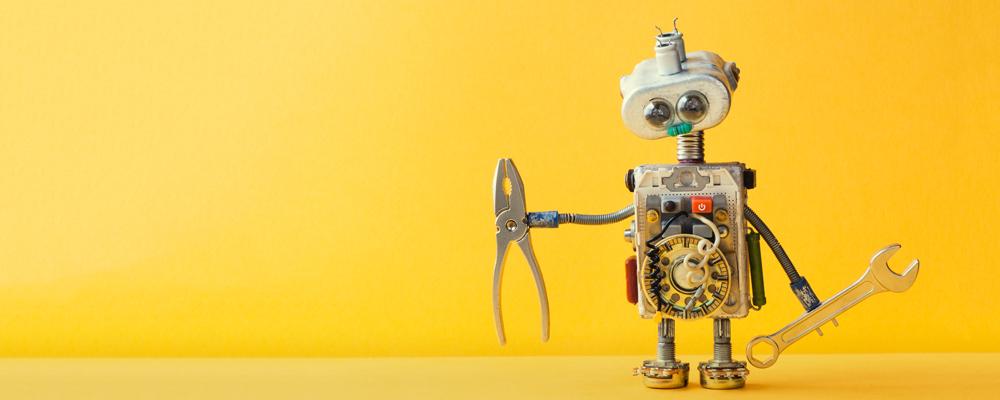
Robots are Not Designers (and Vice Versa)
“I will be there at home and then go to the gym and then I will send you the link to the video of the guy who was the guy.” This masterpiece was written by a robot — specifically, through the “top suggestions” in my SMS app. (I sent it to a friend without context. They are still rather confused).
The message does not remotely reflect what I would type to someone. I don’t say “I will be there at home.” The last gym I went to was a jungle gym. And I don’t know who this “guy” is.
Let’s face it, some things are better done by a human.
Don’t get me wrong, automation isn’t all bad. It can increase productivity, reduce risk and be a driving force for technological advancement. But when applied to design, automation can actually move us away from its intended purpose — to make life better for humans.
Blip Boop Beep Blip Blip (Designers Are Not Robots)
Good design takes personality, passion and deep thought. It’s not simply about inputs and outputs. Yet, sometimes designers fall into that trap, completing their tasks robotically, offering up one-size-fits-all solutions to design challenges rather than sparking imagination.
Sure, there are times when an automated or “robotic” approach might be warranted — say, in cases when a client needs something quick that doesn’t require strict usability standards. That’s where tools like SquareSpace or Wix can come in handy. Certainly as trained designers we can make these kinds of projects look better than an automated program might, but using these tools may be the best solution in these instances.
Still, designers need to make the effort to remain engaged and willing to make hard decisions to create something special when special is what’s needed. And, we need to be able to identify when automation helps and when it hurts. So how can you tell?
Beep Blip Boop Blip Beep (Why Designers Need to Be Better)
Automation is everywhere these days. Our society seems to have a strong demand for perfection (Simon Winchester literally wrote the book on it), which means it’s only a matter of time until we try to automate every aspect of our lives. The thinking here is that humans are flawed, and robots are not. However, “flaws” are subjective, and robots certainly have their shortcomings. (I’m looking at you, Tomatan.)
So when does automation in design make sense? For one, when a client prioritizes cost and speed over quality. Yes, a human designer might make it easier to bring a client’s vision to life. But the convenience afforded by automated tools might supercede that human interaction.
If there’s one thing we should have learned from the fall of Kodak, it’s that people more often care about convenience than quality. Kodak made a perfect storm of bad decisions, and although they put money in the emerging digital market, they were late to fully invest their hearts. In the end, they voted for photo storage and printing, trying to develop the highest quality, and missed the reason consumers were moving toward digital. It was a costly mistake because even though the quality wasn’t good at the time, the convenience was what people wanted from a camera. Not convenience to print, but convenience to take and share an image.
As a flesh-and-blood designer, it is your responsibility to first determine what a client’s end game is. Do they need something extremely quickly? Do they care more about speed or quality? Are they simply looking to present information or do they require true inspiration? If it’s great design they seek, robots have no place at the table. It’s up to you to show your clients why great design — human-powered design — will get them the results they seek. You’re more valuable than the Design-Bot 3000 but it's up to you to prove it.
Shut Down Sequence, Initiated (Closing Thoughts)
Earlier this August, Chicago Cubs’ second baseman Ben Zobrist was ejected from a game for disputing a strike. It wasn’t so much the dispute that got him ejected, but rather his statement, “This is why we want an electronic strike zone.” He’s looking for perfection. But, to me sports should be about entertainment, not perfection. I’m not trying to start a debate about whether or not we should have an electronic strike zone. I’m just saying, some things simply don’t need automation. Like design, most of the time.
But here’s the thing: it’s difficult to make the case that clients should spend their money on a “real” designer when many designers do little more than a computer program or algorithm might. As designers we're supposed to educate our clients. Inspire them. A robot can’t do these things.
At ICS, designers are encouraged to cultivate relationships with clients that extend beyond handing off a piece of work. The company supports our daily efforts to be stronger designers. This recipe might not keep robots from taking over our jobs. But if nothing else, it provides great value to our clients and a great work environment for our team members. Becoming a robot doesn’t sound appealing to me, and hopefully it doesn’t sound appealing to you.
Now if you’ll excuse me, I’m going to search for the video of the guy that was the guy.
Like this article? Read more of our UX design content here.